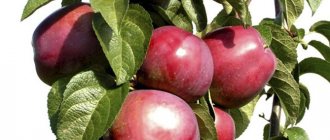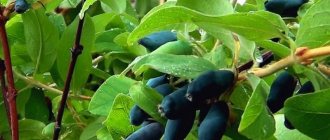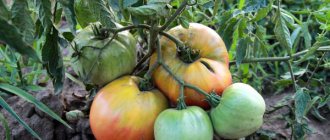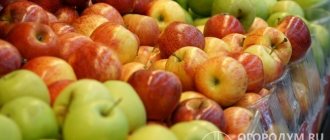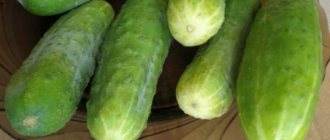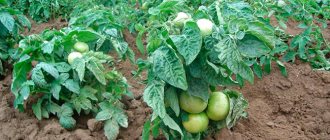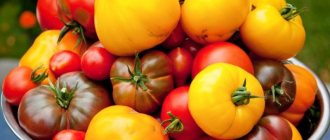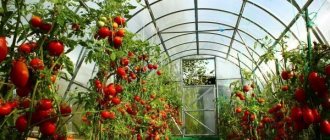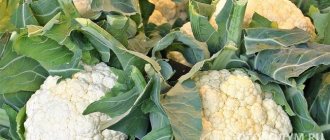The North-Western region of Russia is not among the favorable regions for agriculture in general, and for gardening in particular. Specific climatic conditions and infertile soil can nullify all the efforts of gardeners. But, despite the difficulties, enthusiasts of their craft were able to withstand the struggle for the harvest and develop various varieties of apple trees specifically for the north-west.
Apple tree variety for the Leningrad region.
Conditions for growing apple trees in the northwest
The Leningrad region, like the entire northwestern region, is characterized by cold, unstable winters, short and cool summers, an abundance of precipitation, a very limited fertile soil layer and a high level of groundwater.
Unfavorable factors that affect the growth and development of fruit trees:
- frequent winter thaws;
- sudden changes in winter daily temperatures;
- low depth of snow cover, which, moreover, sometimes completely melts in the middle of winter;
- frequent changes in wind direction;
- uneven precipitation.
Gardeners have to adapt to difficult weather conditions, selecting those fruit crops that can be grown with minimal damage to the tree itself.
Varieties of fruit trees and berry bushes.
This article lists the best zoned varieties of fruit trees and berry crops for the Leningrad region according to the recommendations of the VIR nursery in Pavlovsk. Pears Summer varieties of pears
- Memory of Zhigalov
- In memory of Yakovlev
- Severyanka
- Capfedral
- Otradnoe
- Marble
- Hungarian
- Tula black
- Repair codes
- Hungarian Pulkovskaya, Hungarian Michurinskaya
- Eurasia -21
- Volga beauty
- Rengold collective farm
- Rengold Soviet, Rengold Kuibyshevsky.
- Lisa
- Pavlovskaya yellow, Ruby.
Cherry plum
- A gift to St. Petersburg - an early variety, it needs a pollinator, the fruits are not large, sweet, early, and reach well.
Cherry
- Opukhtinskaya, Pamyati Velyaminov, Morozovka, Molodezhnaya, Zhukovskaya - all these varieties are self-fertile.
- Vladimirskaya is a frost-resistant variety and is a good pollinator.
Cherries
Cherry is a heat-loving crop and in our country it can freeze out.
- Leningradskaya black
- Prima
- Commonwealth - the largest-fruited variety
- Firstborn, Bryansk pink, Swan, Nightingale, Souvenir, Leningrad giant.
- Kazakova varieties: Balsam
- Shy, Companion, Sunny, Bryansk Ruby, Kuzmina News,
- Meteor is an early variety.
- Trojan
- Yellow giant, Sweetweed yellow, Yellow-fruited yellow.
- Kichina varieties: Padishah, Patrotsio, Taganka, Malakhovka - these varieties are winter-hardy and low in height.
- Rubinovaya, Volnitsa.
- Remontant varieties: Indian Summer, Yellow Remontant, Orange Miracle, Bryansk Miracle.
Honeysuckle
All of the following varieties are large-fruited:
- Nymph, Morena, Amphora, Roxana, Volkhova.
Gooseberry
- Olavium is a prickly variety, Finnish, resistant to powdery mildew, red, sweet berries, productive bush.
- Kuibyshev chokeberry - large berries, dark red color, dessert taste.
- Plum - the berries are large and sweet.
- Nugget - the berries are very large, but the bush is susceptible to powdery mildew.
- Seedling Lefort - the berries are very sweet.
- Neslukhovsky - red berries.
- Krasnoslavyansky is a productive, low-growing variety, the berries are very tasty and aromatic.
- Masheka is a Belarusian variety, prickly, the berries are large, sweet, yellow-orange in color.
- Isabella – green berries, grape flavor.
- Malachite is a dark green berry.
- Beryl, Russian yellow.
- Commander is a variety without thorns.
Black currant
- Veloy is a medium-late variety, harvested in two or three times.
- The delicacy is a mid-early variety, the berries are very tasty.
- Green haze - the berries are large and tasty, but it is not resistant to the bud mite.
- Venus - the berries are very large and tasty.
- Dobrynya and Nika are very large berries.
- Peru and Gulliver are large berries.
- Poetry is a very good variety, but is susceptible to bud mites.
- Nika - the berries are large and very tasty.
- Slastena – the berries are very tasty.
Red Ribes
- John-van-Tet
- Beloved
- Rolland
- Red Andreichenko, Natalie.
Strawberries
- Marvelous, Krasnoselskaya, Beauty, Ruby pendant.
- Sudarushka
- Carmen
- Junia Smythe
- Venta
- Surprise Olympics (variety produced from the Festivalnaya variety).
- Pineapple
- Cinderella
- Slavutich
- Rusich
- Ruby pendant.
How to choose an apple tree for the northern regions
The most important qualities when choosing:
- winter-hardy and frost-resistant species;
- precocity;
- disease resistance;
- height of an adult tree - tall, medium-sized and low-growing apple trees (dwarf);
- self-fertility (self-fertile - self-pollinating varieties that do not require cross-pollinators or pollinating insects);
- taste characteristics of fruits.
The main goal of the gardener is to achieve abundant yields of fruit crops. At the same time, it is desirable to minimize material costs and physical labor for growing and caring for the garden.
Advice from experienced gardeners
The first rule of a gardener in caring for any variety of apple tree is not to leave the tree without care. It’s not enough just to plant. Lack of pruning, annual fertilizing, and treatment against pests is almost guaranteed to lead to the death of the tree or the absence of a harvest on it.
Considering that many fruitful varieties require the presence of other apple trees on the site, it is best to take care of this right away, taking it as a guide to action. Several seedlings are selected for planting at once, focusing on their suitability to the climatic characteristics of the region.
A year ago, I planted early varieties of apple trees at the dacha, but the varieties turned out to be not suitable for our climatic conditions and did not take root. I decided to purchase new frost-resistant trees.
But what kind of apple tree should I plant? I began to study apple tree varieties for the Leningrad region. Here's what I found out. Attached photos and reviews.
How to choose a variety based on ripening time
According to the time of ripening, apple trees are conventionally divided into early (summer), middle (autumn) and late (winter). Apples of summer varieties are practically not stored - they are only good when fresh, so a large harvest of such apples is not needed. Apples of autumn varieties can retain their presentation and taste for up to 2.5 months, in addition, they are well suited for further processing.
Ripening apples on a branch.
Winter varieties are stored for long-term storage. Apples are removed from the tree slightly unripe; during storage, the fruits ripen. For winter apples, the concept of “keeping quality” is important: the longer the fruits can be stored, the longer you can eat apples from your own garden.
Rootstocks of the All-Russian Scientific Research Institute of Horticulture. I. V. Michurina.
3-6-47 - dwarf rootstock. The wood is strong and not brittle. Winter hardiness is high. In the nursery it produces strong, almost non-branching shoots and is technologically convenient. Compatibility with varieties is normal. As an intercalar it produces dwarf and semi-dwarf trees.
3-17-38 - dwarf rootstock. The wood shows slight fragility. Winter hardiness is high. In the nursery it produces straight, technologically convenient yearlings. Compatibility with varieties is normal. As an intercalary it forms dwarf trees.
3-3–72. In terms of growth strength, it is average between a dwarf and a semi-dwarf. The wood is durable. Winter hardiness is very high. As an intercalar it produces semi-dwarf, early-fruiting and productive trees. 2-46-146. Semi-dwarf rootstock. Winter hardiness is high. Compatibility with varieties is normal. As an intercalar it produces semi-dwarf - medium-sized, productive trees.
3-4–73. The rootstock is semi-dwarf in terms of growth vigor. The wood is durable. Winter hardiness is high. In the mother liquor it produces strong, straight shoots. Compatibility with varieties is good. As an intercalar it produces semi-dwarf, early-fruiting and productive trees.
3-4–98. Semi-dwarf rootstock. The wood is durable. Winter hardiness is high. Produces many strong straight shoots in the queen cell. Compatibility with varieties is normal. How intercalar forms semi-dwarf - medium-sized trees.
Evgeniy Bezukh, Ph.D. agricultural sciences,
Leningrad fruit and vegetable experimental station
The best apple varieties for the Leningrad region
When choosing an apple tree, you should not forget one more important factor: the variety must be zoned, i.e. recommended for cultivation in a certain region.
Thanks to the many years of work of breeders, many varieties of apple trees have appeared for the Leningrad region. The well-known Antonovka, White Nalivka or Melba are being replaced by new varieties that attract the attention of gardeners with good quality fruits and high stable yields. We recommend that you take a closer look at those varieties that were included in the State Register of Breeding Achievements, approved for use from the 90s of the 20th century to the present day. They best meet the requirements of modern gardeners. And of course, don’t forget the old varieties that have been proven for decades. Moreover, all new ones are bred using ancient varieties of folk selection that have long proven themselves to be excellent.
Early summer ripening apple trees
Summer varieties of apple trees: fruit ripening time is mid-July - early August, shelf life up to 3 weeks. Compared to late varieties, apples taste sweeter and the flesh is not as dense. Summer varieties are characterized by good frost resistance, but do not tolerate sudden temperature changes, especially characteristic of spring.
Early ripening summer apple tree Avenarius.
Table: summer apple trees for the Leningrad region
Variety name | Winter resistance | Yield _ | Stand- chivalry to the scab | Start fruit-bearing sewing, years | Fruit size | Term storage apples, weeks | Additionally |
| Avenarius | IN | JV | IN | 4–5 | WITH | 2–3 | Non-self-fertile |
| Wine | IN | VP | IN | 5–6 | C► | 6–8 | Ribbed fruits |
| Gornoaltaiskoe | IN | SR | IN | 4–5 | M | 3–4 | Non-self-pollinating |
| friendship of Peoples | IN | VR | IN | 4–5 | WITH | 5–7 | Summer, non-self-pollinating |
| Elena | IN | VR | WITH | 2–3 | WITH | 2 | Self-pollinating |
| Kovalenkovskoe | IN | VR | WITH | 3–4 | TO | 4 | Late summer. |
| Pirya | IN | VR | IN | 2–3 | WITH | 2 | Early summer, dwarf. |
| Northern dawn | IN | WITH | WITH | 4 | ◄С | 4 | Fruits are slightly ribbed |
| Suislepskoye (Malinovka) | WITH | N | WITH | 6–8 | WITH | 2 | Ribbed apples |
Designations in the table:
- B – high indicator;
- C – average;
- N – low indicator;
- P – periodic;
- R – regular;
- K- – large;
- M - small.
- ◄С – average and less than average;
- C► – average and above average.
Autumn apple tree varieties
They differ from summer ones in their large fruit size, rich bright color, ripening and storage time. The main time for harvesting fruits is September.
Autumn apple tree variety Anis scarlet.
Autumn apples are universal:
- they are good to eat straight from the tree;
- autumn apples are stored for up to two and a half months;
- excellent for subsequent processing (jams, jams, jams, compotes, dried fruits, wines).
Table: autumn varieties for the Leningrad region
Variety name | Winter resistance | Yield | Stand- chivalry to the scab | Start fruit-bearing, years | Fruit size | Term storage apples, months | Additionally |
| Scarlet anise | IN | VP | IN | 6–7 | M | 1,5 | Self-sterile |
| Baltika | IN | IN | WITH | 5–6 | ◄С | 2 | Non-self-pollinating |
| Bessemyanka Michurinskaya | IN | VR | IN | 5–6 | WITH | 3,5 | Needs pollinators |
| Jonagold | WITH | VR | WITH | 3 | TO | 6 | Not new, but included in the state register of approved varieties only in 2016, pollinators are required |
| Chosen One | WITH | VR | WITH | 4–5 | C► | 3 | Dessert taste of apples. |
| Cinnamon new | IN | VP | IN | 5–6 | C► | 4–5 | Highly commercial fruits |
| Autumn striped (Streiflig) | IN | VR | WITH | 8–9 | S►K | 3 | Highly commercial fruits |
| Delight | IN | VR | IN | 4–5 | TO | 3–4 | Early autumn, low growing |
Winter apple trees
The main difference between winter varieties of apple trees is that their fruits can be stored for a very long time without losing their nutritional value and presentation. Many early varieties cannot boast of the excellent aroma of fruits, which in winter varieties persists for a very long time.
The fruits of winter apple trees are not recommended to be eaten immediately after picking: the thick peel and hard, often sour pulp will not bring any gastronomic pleasure. The apples need to rest for some time to achieve the best conditions. Only then will it be possible to fully experience the taste and aroma of the winter apple.
Winter apple tree Idared.
In order for apples to reach the desired condition, they must be stored at a certain temperature and humidity. This process is called ripening. During the ripening process, the fruits acquire a color characteristic of the variety, the acid content decreases, starch turns into glucose and, as a result, we get a sweet, juicy and beautiful apple.
Table: winter varieties for the Leningrad region
Variety name | Winter resistance | Yield _ | Stand- chivalry to the scab | The beginning of fruiting wearing, years | Fruit size | Term storage apples, months | Additionally |
| Idared | WITH | VR | WITH | 5–6 | TO | 7–8 | Late winter, requires pollinators |
| Alesya | IN | VR | IN | 3–6 | TO | 5–7 | Late winter |
| Antey | IN | VR | WITH | 3–4 | TO | 4–6 | Late winter, ribbed fruits |
| Aelita | IN | VR | IN | 5–6 | WITH | 5 | Dessert taste of apples |
| Belarusian sweet | IN | IN | IN | 2–3 | TO | 5 | Weakly ribbed, weakly fragrant fruits |
| Venyaminovskoe | IN | VR | IN | 3–4 | WITH | 4–5 | Late winter, non-self-pollinating, wide-ribbed fruits |
| Vesalina | IN | VR | IN | 2–5 | S►K | 5 | Wide-ribbed purple apples |
| Ladoga | IN | VR | IN | 4–5 | C► | 7 | Late winter |
| Memory of Sikora | IN | VR | IN | 3 | C► | 4–6 | Late winter |
| Memory of Syubarova | IN | VR | IN | 2–5 | TO | 5–7 | High precocity |
| Pioneer of the North | IN | WITH | IN | 4 | WITH | 4-6 | Fruits are slightly ribbed |
| Rozhdestvenskoe | IN | IN | IN | 2–3 | WITH | 4–5 | Absolute resistance to scab, dessert taste of fruits |
| Festival | IN | VR | IN | 5–6 | WITH | 4–5 | The fruits are slightly ribbed. |
| Enchantress | IN | VP | IN | 3–5 | TO | 6–7 | Early fruiting, high-market fruits |
Apple tree varieties for Karelia. Start searching for winter varieties
For the last 15 years, in my garden I have been testing many new varieties with a long shelf life, obtained from Orel, Michurinsk, Belarus and North America.
The experience seemed successful to me. The varieties from Orel were the first to please me - Freshness and Imrus. They freeze slightly in our area, although they froze in the gardens of many friends. Firstly, they are immune to scab, and secondly, they are early-bearing and very productive. But the main thing is that they are stored in the basement until spring and delight our grandchildren. About ten years ago, a branch from a cutting I received from Susov bore fruit - it was the Belarusian variety Alesya. I saved the apples until the end of February, until my birthday. When I put them on the table, all the guests and even the little grandchildren noted that they were very sweet and large, and they had no equal in the aroma that filled the room. No one has eaten anything like this. Store-bought ones smell of chemicals and are herbaceous; our old varieties are sour and less aromatic. And Belarusian new products were able to withstand winters down to -35 and produce brightly colored fruits in October, which were stored until May in an ordinary basement. At a time when our breeders in Orel and Michurinsk worked mainly on scab-immune varieties and worsened the taste and keeping quality of their new products, Sinap Orlovsky, Kandil Orlovsky, perhaps the only worthy of the Oryol proven varieties, the breeders of the BelNII Garden carried out a huge amount of hybridization ( more than two million seedlings) and isolated interesting hybrids. And most importantly, after many years of testing, scientists distributed these varieties throughout the gardens. Most of them turned out to be very winter-hardy and were stored until spring.
Features of growing apple trees in the Leningrad region
When planting a garden, you need to take into account all the conditions for the growth of trees:
- soil composition;
- proximity to groundwater;
- compass rose;
- relief of the site;
- tree planting time (autumn or spring).
Based on these calculations, you can begin to select the most suitable varieties and begin planting.
Apple tree planting
The survival rate of the seedling directly depends on the choice of the correct planting time. In the fall, you need to have time to plant a seedling before the onset of frost. Recommended dates for autumn planting in the Leningrad region are from October 1 to October 31. Spring planting should not begin before mid-April; it should be completed no later than mid-May.
Scheme of proper planting of an apple tree.
A week and a half before planting, prepare a hole with a depth and width of at least 50 cm. A small layer of medium-sized stones is poured onto the bottom for better drainage. The soil with which the roots will be covered is mixed with humus or peat. Immediately before planting, the hole is half filled with prepared soil and compacted well. Then a seedling is placed in the center and covered with the remaining soil. The earth is compacted again, a low side is made around it, and the seedling is watered abundantly.
For better stability of a young apple tree, during planting you can stick a peg nearby and then tie the seedling to it.
Reviews from gardeners
...I can recommend the Candy variety - a summer variety, it can begin to bear fruit in the year of planting, the apples are medium-sized, sweet, very tasty. It doesn’t freeze, there was no scab damage (at least on my tree).
mogileva
https://www.websad.ru/archdis.php?code=304975&subrub=%D0%AF%D0%B1%D0%BB%D0%BE%D0%BD%D0%B8%20%D0%B8%20 %D0%B3%D1%80%D1%83%D1%88%D0%B8
I like the Silver Hoof variety the most. The most productive and delicious of all others in our region. It's never been better. Juicy. Elegant, scab-resistant. Winters well. And when ripened on the tree, the golden flesh becomes translucent. At the same time, there is no such thing as “wadding”. We are very pleased and recommend it to everyone. In St. Petersburg it is sold with a closed root system. Therefore, you can plant at any time.
Alexei
https://www.tsvetnik.info/answers/apple-north-west.htm
Melba grows well even here, although I am in the north of the Leningrad region, and my area is inclined towards the lake, and there is wind all the time. In general, everything is growing poorly for me.
Yana Zhdanova
https://vk.com/topic-1105337_22093427
In the Leningrad region there is a very thin fertile layer, so you need to be very careful when handling apple seedlings. The best varieties for this area are Antaeus, Aelita, Melba and Welsea. But first you need to calculate how many varieties there will be: winter, summer and autumn, so that the apples remain fresh all year round.
Vyacheslav Belik
https://agronomu.com/bok/367-sorta-yablon-dlya-leningradskoy-oblasti.html
Golden Chinese, this is ours. Small, really some kind of Chinese taste, you can’t say, neither sweet nor sour - but small, surprisingly transparent when ripe - and this is maximum August and even earlier and something amazing...:-)...
Griefmaster
https://www.mastergrad.com/forums/t148252-podskazhite-sort-yabloni-dlya-pitera/
Before buying apple tree seedlings, ask what varieties your neighbors grow and how comfortable they are in this area. You can select trees with similar characteristics from the presented review. Plant several apple trees of different ripening periods, then your diet will always contain healthy and tasty fruits.
Gardeners usually have two reasons for choosing a dwarf apple tree instead of a regular one: saving space and the opportunity to provide low-growing trees with the most careful care, because their crown does not exceed 3 m in height.
Fruit and berry crops
Fruit trees and shrubs - seedlings
Fruit trees and shrubs - seedlings.
Fruit and berry plants can be divided into:
Trees include fruit trees:
These plants have a clear central trunk.
Fruit bushes
Fruit bushes (gooseberries, currants) do not have such a trunk. Herbaceous forms include strawberries and wild strawberries. Raspberry is a semi-bush form. These plants have a root system consisting of small and large roots. With the help of roots, plants feed on nutrients in the soil that they need for life. Also, substances such as hormones are produced in the roots, and the roots are anchored in the soil, holding the plant in a stable position.
If you are going to buy seedlings of fruit trees and shrubs, it will be useful to know that only vegetative buds can form in the axils of their leaves, which subsequently become vegetative shoots. In pears and apple trees, the vegetative buds are often in a dormant state, which is why they are called dormant. From vegetative shoots, top shoots can develop, which can become a replacement for dying shoots.
In adult fruit plants, in addition to vegetative buds, flowering buds can also form. Flowers will form from them, and then the fruits themselves. Pears, apple trees, gooseberries and currants have mixed buds. Their shoots can form shoots and leaves, as well as flowers. Apricot, cherry, sweet cherry, peach, and plum have simple fruit buds, from which only reproductive organs—fruits and flowers—develop.
Fruit and berry crops can be divided into:
Division occurs based on the internal structure of the fetus.
Quince, hawthorn, pear, apple, rowan, etc. - seed-bearing plants. Their fruits have a fairly developed fleshy system in which the seeds are located - false drupes (soft shell)
Stone fruit plants (plum, peach, apricot, cherry) have hard-shelled seeds in their hearts - these are real drupes.
Red and black currants, raspberries, gooseberries and strawberries develop edible fruits - berries with small seeds.
Fruit seedlings for St. Petersburg and the region. In St. Petersburg, in dachas, the most common fruit trees and shrubs are apple, pear, cherry, raspberry, currant, honeysuckle and gooseberry. Gardeners strive to buy seedlings of fruit trees of representatives that have a certain set of characteristics. In particular, St. Petersburg is characterized by sharp temperature changes, strong winds, heterogeneous and lifeless soils in some areas. Therefore, plant nurseries try to present on their sites a selection of crops with the greatest hardiness.
It is quite easy to buy fruit seedlings in St. Petersburg. Despite the fact that every plant planted in our strip needs additional care, gardeners do not deny themselves the pleasure of buying fruit tree seedlings in nurseries or even just from hand.
How to choose seedlings. Of course, in order to get some kind of harvest that you expected, it is better to choose trusted manufacturers and suppliers of seedlings. in this way you will protect yourself from disappointments that may befall you when buying seedlings on the streets and markets. Most often, the announced variety of seedlings turns out to be completely different. And if you are completely unlucky, then an inexperienced gardener may be sold something completely incomprehensible instead of a fruit seedling.
To avoid the fate of a deceived buyer, you should contact fruit seedling nurseries, where they will help you with your choice if you have not yet decided, and where you can buy seedlings of fruit trees and shrubs of different varieties with a quality guarantee. Buy fruit trees at the Maxiplant nursery. You can buy fruit tree seedlings in St. Petersburg in our nursery “Maxiplant”. A large selection of varieties of apple trees, pears, cherries, cherries, currants, raspberries and other tasty and high-yielding fruit trees and shrubs, adapted to the difficult climatic conditions of St. Petersburg and the Leningrad region!
The plant nursery "Maxiplant", located in the Leningrad region, Kirov district, next to the Nevdubstoy railway station, offers to buy seedlings of fruit, as well as ornamental and coniferous trees and shrubs, beautiful flowers and lint on its trading platform.
Delivery of seedlings throughout St. Petersburg and the Leningrad region.
general characteristics
Still, gardeners have to take local conditions into account. So as not to be upset later by failures and money spent. And start over again in 5-10 years. So pay attention:
- For winter hardiness;
- The ability to resist diseases. Especially fungal diseases. Especially scabby;
- Early frosts force you to pay attention to varieties that have time to ripen by then.
You will also take into account:
- Tree type: Height;
- Width;
- Dense or sparse crown;
- What does it look like - a pyramid, a ball or an oval;
- Plant Antonovka, and it will take up half the plot.
- Apple Type: Size;
- Coloring;
- Even shades and patina.
- Sweetness;
- How long to wait for the first harvest: Maybe you don’t have the patience to wait 7-8 years.
- Isn’t it necessary to have a place on the market to sell them?
We will look at the specific best varieties of apple trees below.
It is interesting to read reviews from gardeners. And not dry academic assessments of specialists. After all, according to some experts, it is necessary to get rid of some ancient varieties. Antonovka, Korobovka, Grushovka Moskovskaya, White filling need to be changed. And they are in good demand. I also have Borovinka. New items attract attention. I would like to grow both Silver Hoof and Belarusian Raspberry. Yes and others. But mine is enough for me.
I have been renovating my garden for several years. But from the old ones I still leave White filling and Glory to the winners. Iyulskoe Chernenko, Antey, Krasa Sverdlovska complemented the assortment very well. The Baltic and Finnish varieties are interesting. I'll take a closer look. Nurseries offer. But we need expert advice. Who has had them for more than a year?
I have also been working on columnar apple trees on my site for several years. There are a lot of advertisements. The cost is decent. But so far they cannot replace our reliable ones - White filling, Zvezdochka, Streifling, Bogatyr. They look beautiful. And the taste is not very satisfying. Maybe I'm rushing to conclusions? But the columnar ones bear fruit earlier. A dozen apples are just for variety.
Two varieties from the Ural collection delighted me. Its winter hardiness and productivity. Beauty of Sverdlovsk and Silver Hoof. I advise others to plant it at home. You will not regret.
Belarusian sweet
Late winter high-yielding, self-fertile variety of Belarusian selection.
The variety has excellent winter hardiness and is absolutely resistant to scab and wood cancer.
The tree is medium-sized (up to 3 m), fast-growing, with a sparse, compact green crown of a round-conical shape. It begins to bear fruit in the 2-3rd year, it is early-bearing, apples are harvested in September-October, not at the same time. Productivity is consistently high, without periodicity. Fruiting is regular, the fruits are firmly attached to the branches and are not prone to falling.
The fruits are round, slightly flattened, medium to large in size (150-200 g), with a light aroma. The color is yellow-green, tightly “closed” with a blurred dark pink blush. The skin is smooth, the flesh is very light, juicy, tender, coarse-grained. The taste is absolutely sweet – sugar content is within 10%. The harvest can be stored without refrigeration for up to 4 months.
